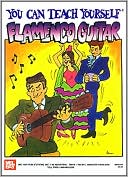

 |

|

The average rating for You Can Teach Yourself Flamenco Guitar based on 2 reviews is 3 stars.
Review # 1 was written on 2014-04-29 00:00:00 Freeman Rawdon Freeman RawdonGreat and straightforward I would recommend this book to anyone learning the guitar. It is simple and concise. It is great because it gives you songs to play. |
Review # 2 was written on 2015-01-01 00:00:00 Nicholas Capelety Nicholas CapeletyThe cover art of this book is the striking visual of the normal modes of a vibrating drum head made visible by sand coalescing into patterns on a kettledrum head. Known as Chladni patterns after their 18th Century discoverer, these same images caught my imagination as an undergraduate on the cover of the Third Edition of Boundary Value Problems (David L. Powers). From that time until know, I have always felt modeling music is a particularly enlightening way to understand ODEs, Fourier analysis, the wave equation, and … music. This book does not necessarily require greater mathematical knowledge than that imparted by something like the Powers textbook and no real close understanding of music is required, either. But, with a fundamental knowledge of the wave equation and solving ODEs along with at least a passing interest in music, this text will raise the avid reader's knowledge and appreciation of subjects both mathematical and musical. The material in this book sprung from the author's fascination with the early purchase of a second-hand synthesizer which developed into an undergraduate mathematics course taught over the period of a few years. It is then natural for this book to start as it does from very basic concepts of defining sound, sound mechanics in the human ear, trigonometry basics, damped harmonic motion, and resonance. Fourier theory is introduced and built up to Bessel functions, the Hilbert transform and related topics. These preliminaries are complete in the first two chapters and are there if required, or a prepared reader can dive right into the encyclopedic third chapter, "A Mathematician's Guide to the Orchestra". The third chapter is the first of seven that overview a musical topic in a methodical, organized approach. Each such chapter breaks its subject up into classifications make this work both a guided tour and a reference work on mathematics and music. Chapter 3 starts from the wave equation for strings to mathematically modeling and determining the vibration modes for stings, wind instruments, drums, horns, xylophones and more. Each section on a class of instruments includes suggestions for further reading. An additional chapter considers consonance and dissonance, including a fascinating section on musical paradoxes where consideration is made of ways to trick the ear. Two chapters take on the idea of scales from the basic notion of the Pythagorean scale and the cycle of fifths to such alternative scales as those of Harry Partch and Wendy Carlos. This has at its heart an examination of and application of continued fractions. An additional two chapters consider digital music starting from the basics of digital signals and dithering and includes a granular overview of the MP3 and WAV file formats. Fourier transforms are brought in for analyzing synthesis of sounds and practical application is made through examples in the CSOUND programming language. A final fascinating chapter is "Symmetry in Music". Through modular arithmetic and some group theory (Cayley, Burnside, etc.) basic concepts of symmetry in music are made clear. Like the other chapter and related chapter groups, "Symmetry in Music" can stand alone both on the musical topic and as an example of an application of group theory. This work is fully indexed and includes several pages of bibliography and reference works. There is also an "octave" of eight appendices that cover Bessel functions, scales, MIDI charts, a table of intervals referenced back into the text, music theory, and a lengthy list of recommended recordings. (Many sections of the work have context-specific recommended recordings.) Cambridge University Press allows the author to keep a free online version of this text at |
CAN'T FIND WHAT YOU'RE LOOKING FOR? CLICK HERE!!!